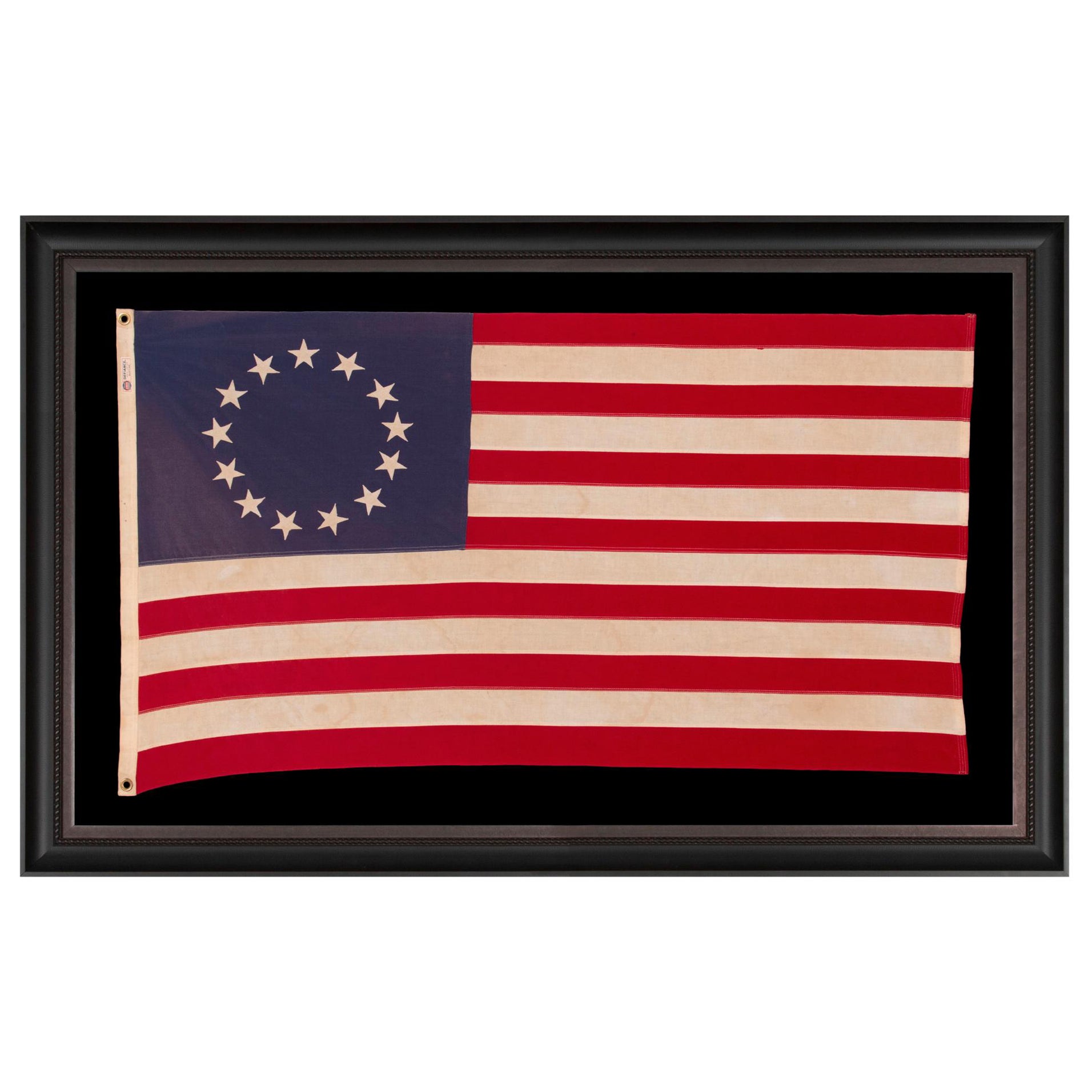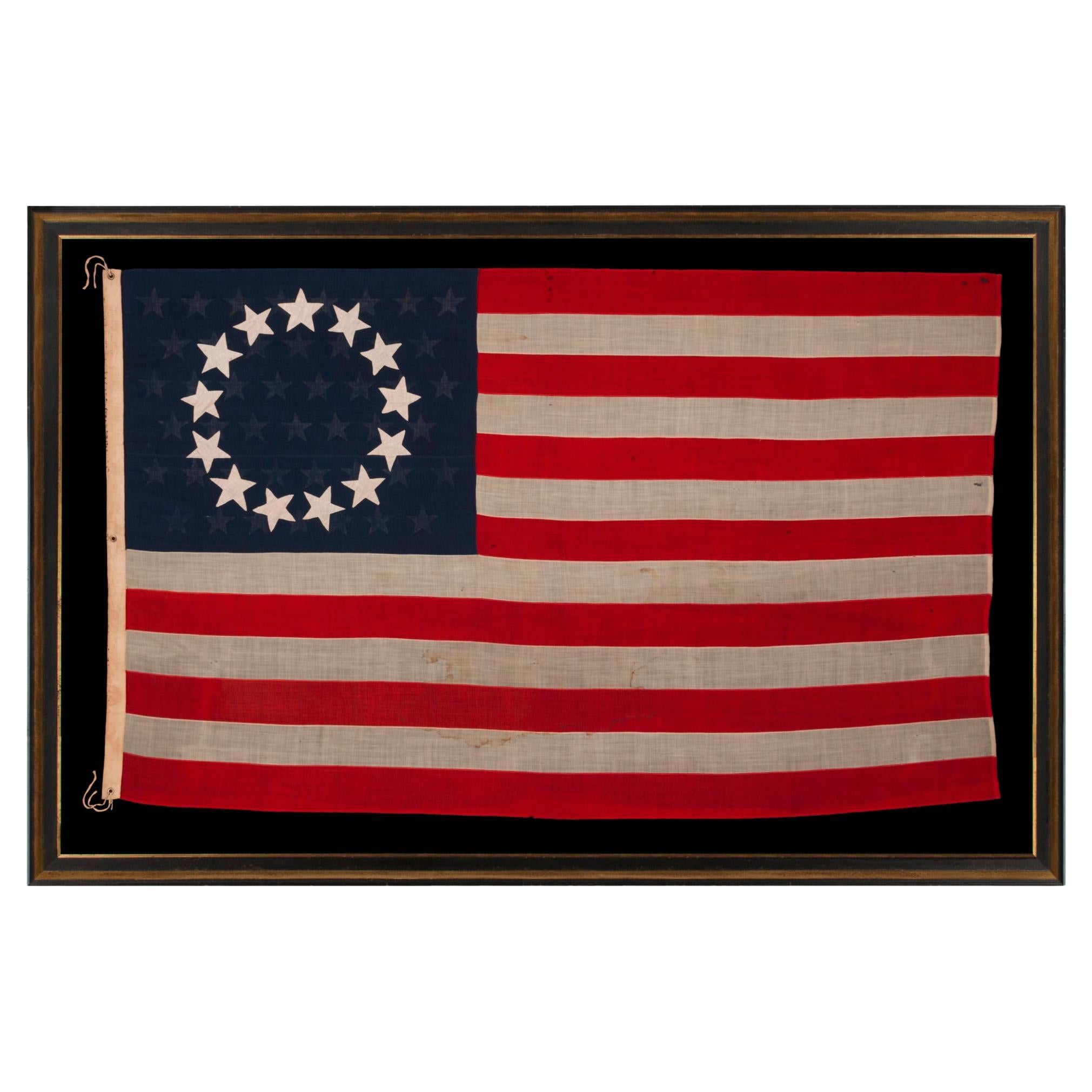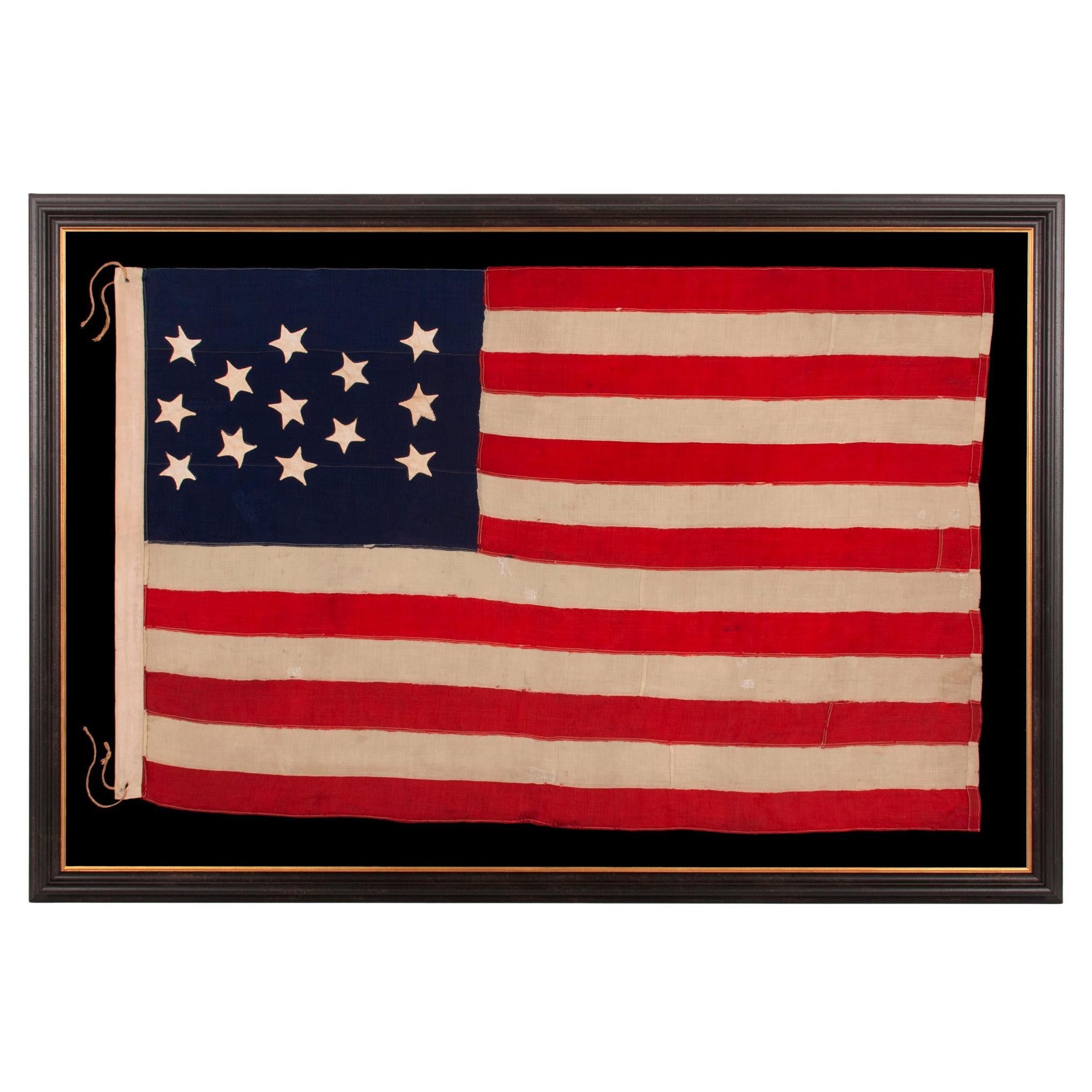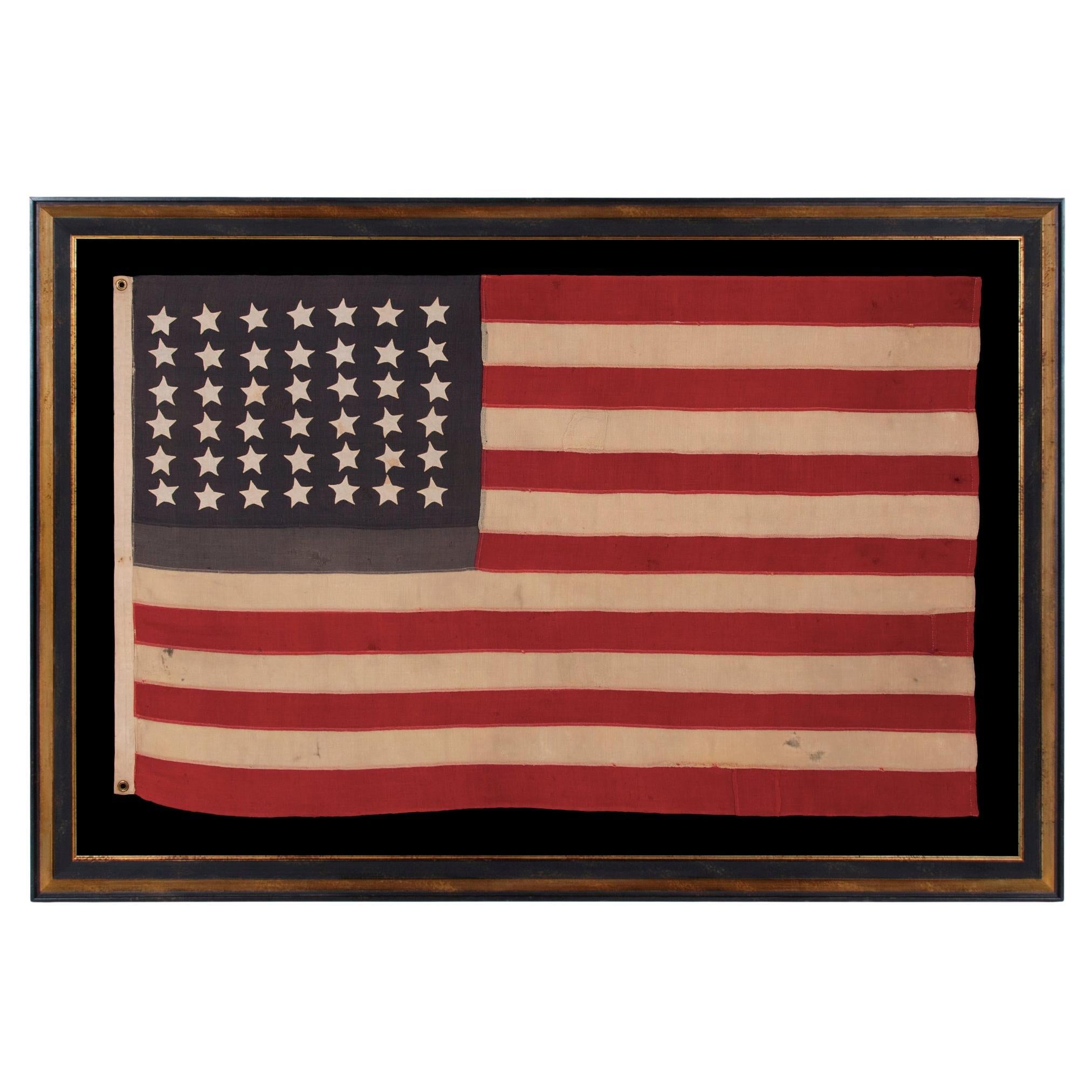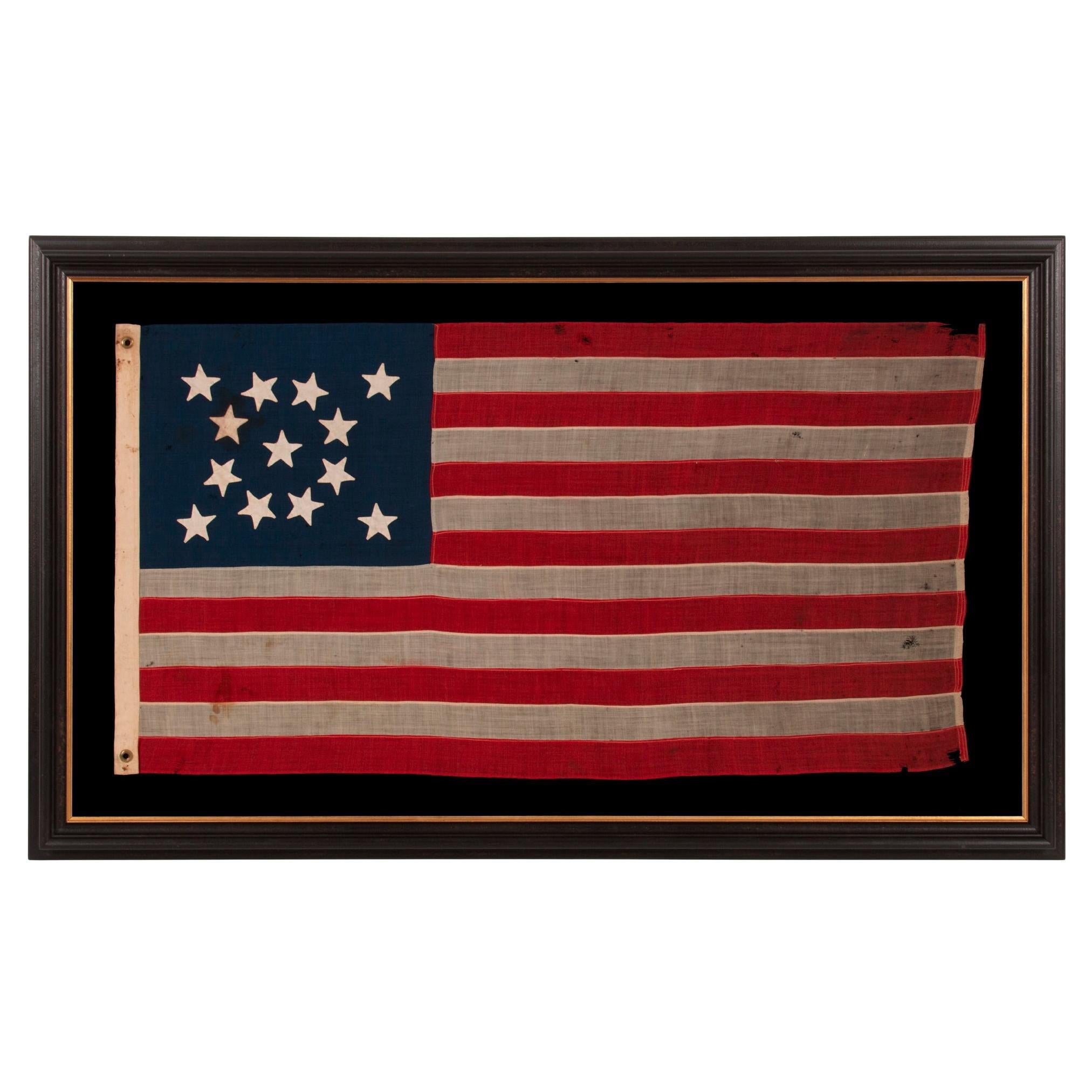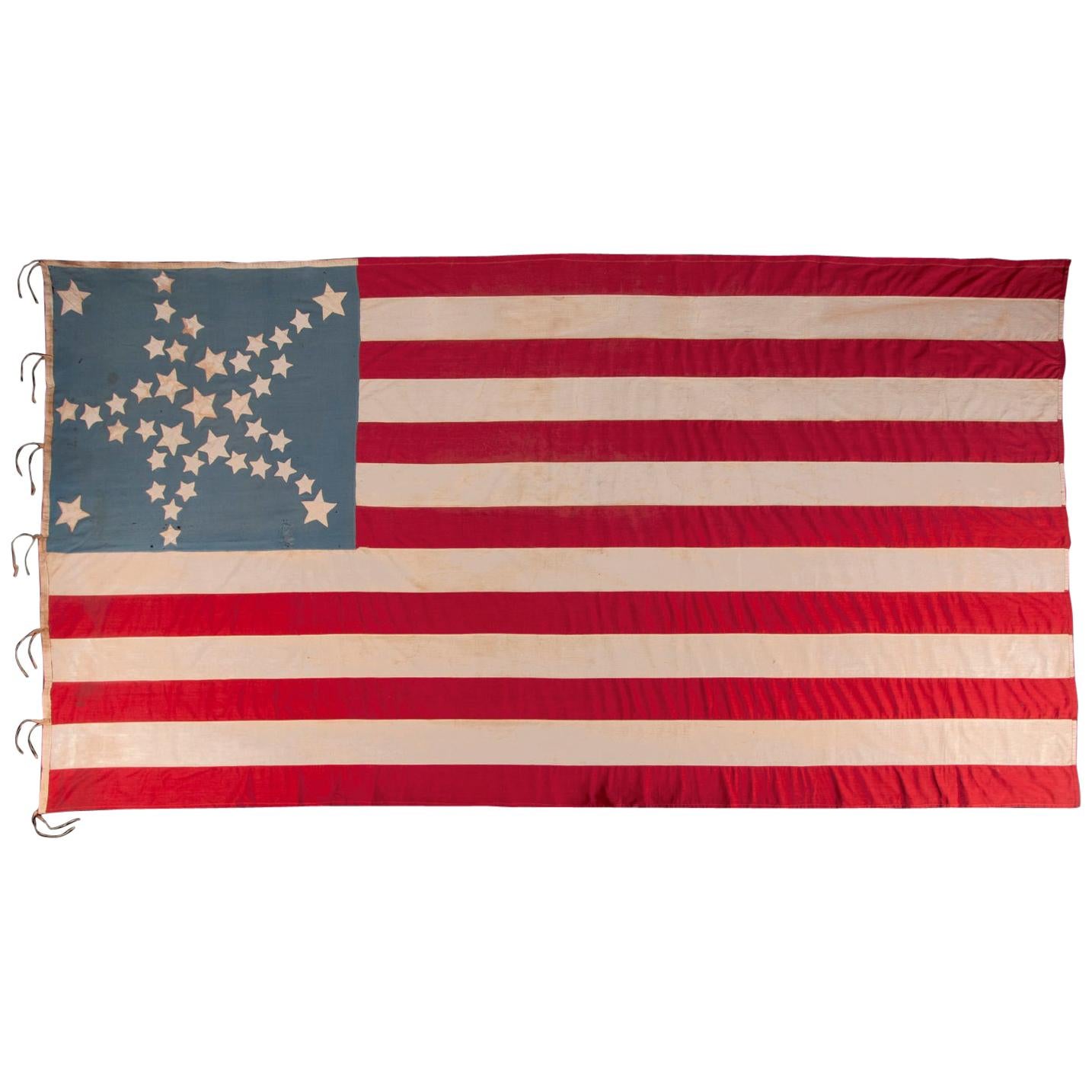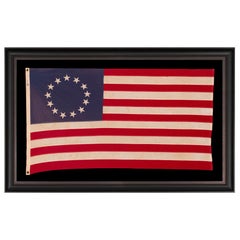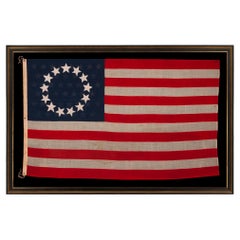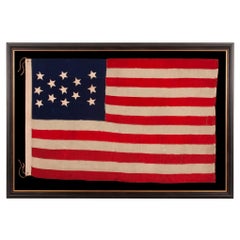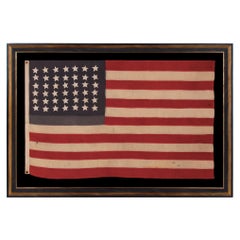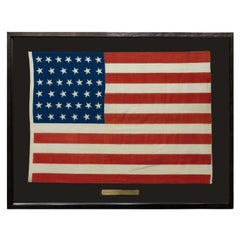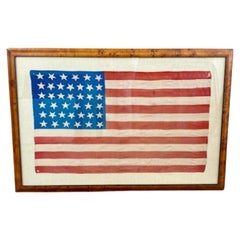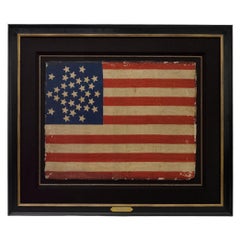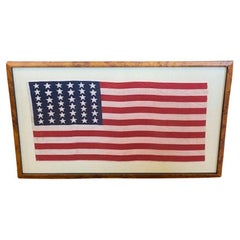Items Similar to 13 Stars in a Betsy Ross Pattern, ca 1910-1926
Want more images or videos?
Request additional images or videos from the seller
1 of 7
13 Stars in a Betsy Ross Pattern, ca 1910-1926
Price Upon Request
Price Upon Request
Price Upon Request
Price Upon Request
Price Upon Request
Price Upon Request
Price Upon Request
Price Upon Request
Price Upon Request
Price Upon Request
Shipping
Retrieving quote...The 1stDibs Promise:
Authenticity Guarantee,
Money-Back Guarantee,
24-Hour Cancellation
About the Item
13 STARS IN THE BETSY ROSS PATTERN ON A SMALL-SCALE ANTIQUE AMERICAN FLAG MADE SOMETIME BETWEEN APPROXIMATELY 1910 AND THE 1926 SESQUICENTENNIAL OF AMERICAN INDEPENDENCE
13 star flag of the type made from roughly the last decade of the 19th century through the first quarter of the 20th. The stars are arranged in the circular wreath pattern most often associated with Betsy Ross. Flags in this design are widely admired, due to the longstanding popularity of the Betsy Ross myth. While many Americans were taught in grammar school that this was what our first flag looked like, there is unfortunately no way to prove the claim. No colonial examples have survived with this pattern of stars. In fact, I have encountered just three surviving examples of Betsy Ross pattern flags that I believe to pre-date the 1890's.
Because there was no official star pattern for the American flag until 1912, just after New Mexico and Arizona entered the Union as the 47th and 48th states, the arrangement before that time was completely left to the liberties of the maker. As a result, there are more than 80 known star patterns for the 13 star count alone.
The canton and stripes of the flag are made of wool bunting that has been pieced with machine stitching. The stars are made of cotton and double-appliquéd (applied to both sides) with a zigzag machine stitch. There is a twill cotton binding along the hoist with three white metal grommets, along which “2 x 3” appears in a black-inked stencil, near the top, on the obverse, to indicate size in feet. Adjacent to this and perpendicular to it, the number “11” is inscribed in black, while “No. 11” appears on the reverse of the binding in teal blue grease pencil. Near the top, a penciled inscription, difficult to decipher, reads “Betsy Ross.” Together the elements of the flag’s construction point to the period between approximately 1910 and the 1926 Sesquicentennial of American Independence.
Why 13 Stars? As the number of stars grew with the addition of new states, it became more and more difficult to fit their full complement on a small flag. The stars would, by necessity, have to become smaller, which made it more and more difficult to view them from a distance as individual objects. The fear was that too many stars would appear as one white mass, at a distance and distort the ability to identify American ships on the open seas.
The U.S. Navy flew 13 star flags on small craft for precisely this reason. This was, of course, the original number of stars on the first American national flag, by way of the First Flag Act of 1777, and equal to the number of original colonies that became states. To the Navy, a small flag generally meant anything short of 10 feet. Prior to the 1890’s, the smallest sewn flags encountered with any regularity were approximately 6 feet on the fly. Because the primary use had long been more utilitarian than decorative, flags needed to be large to be effective as signals. Private use grew with the passage of time, however, as did worldwide ability to recognize the American flag, both of led to the production of flags of smaller scale.
In 1864, the newly released regulations for U.S. Navy small boat ensigns assigned each specified size with a numeric designation. In 1864 and 1870 regs, a No. 11 ensign measured 4.2 feet on the hoist by 8 feet on the fly. This size designation was removed until 1914, when it reappears with corresponding measurements of 2.37 x 4.5 feet. In neither instance does this correlate with the 2 x 3 foot specs of the Betsy Ross pattern flag that is the subject of this narrative. The Navy made its own flags at various locations, some of which were marked and dated. Because they sometimes acquired them simultaneously from commercial makers, ships’ chandlers and other sources, all of which appear to have loosely followed Navy specs in such instances—or else the Navy remained flexible, perhaps caring more about expediency and price, actual measurements varied greatly. This is hardly the only time that I have seen Navy designation on a flag stenciled with measurements that only loosely correspond.
Beginning around 1890, commercial flag-makers began to produce smaller flags for the first time in large quantities. These typically measured either 2 x 3 feet (like this example), or 2.5 x 4 feet. Applying the same logic as the Navy, they selected the 13 star count rather than the full complement of stars, for the sake of ease and visibility. Any flag that has previously been official remains so according to the flag acts, so even today 13 star flags remain official national flags of the United States of America.
One of the interesting misconceptions about 13 star flags is that an open, circular wreath pattern, even if not the original design, must have been common in early America. Logic would suggest this, given the frequency with which it appears in modern times. This was not the case, however; in fact, the pattern is seldom encountered anywhere until much later. Exceptions include a 1779-1780 painting of George Washington at the Battle of Princeton, by Charles Willson Peale, that depicts, in the background, a flag that appears to have a circular wreath of stars, but no stripes. This is one of the few appearances of a circular pattern in a work period to the Revolutionary War, yet it wasn’t the national flag and Peale may have used some artist’s liberty in its inclusion. While known to be especially detailed and keen on accuracy, Peale made at least four copies of the painting prior to 1782, one of which shows the Battle of Trenton in lieu of Princeton (the original), so he obviously wasn’t opposed to alterations. Trumbull, included a flag with what may be a circular pattern in a 1787 painting of the Battle of Yorktown, but the flag is waving and it is not known if the intended design was to be circular or oval.
Francis Hopkinson, credited designer of the Stars & Stripes, actually rendered a circular pattern of 13 eight-pointed stars, presented like the rowels of a spur, on a piece of 1778 Philadelphia currency. This did not show a flag and was not part of one. He included a similar rendering, surrounding a liberty cap, on a 1778 draft for the seal of the U.S. Board of War, but there is a flag affixed to the liberty pole on which the cap rests, and the flag, which displays only stars, arranges them in a 4-3-4-2 lineal pattern.
The only surviving 18th-century illustration of a 13 star, Stars & Stripes with a circular wreath and no center star, appears in a sketch by William Barton, which served as his 2nd draft for the Great Seal of the United States, presented to the 3rd Committee designated to select it. Though it does not survive, Barton’s first draft is also said to have included such a flag. The final draft was not rendered by Barton, but by Congressional Secretary Charles Thompson, who included no flags, but did include an arrangement of 13 stars above the head of a federal eagle, placed in a random pattern. It is of interest to note that Francis Hopkinson produced some of the initial drafts of the seal, which also included 13 stars in a random scatter (fig. 4).
One of the best arguments against the Betsy Ross pattern having appeared on the original flag is illustrated by the fact that so many 13 star flags exist without it. If the Ross design was the original, it stands to reason that the pattern would have been reproduced with at least some degree of frequency.
Research conducted by the National Museum of American History notes that the story of Betsy Ross making the very first American flag for General George Washington, in the company of George Ross and Robert Morris, entered into American consciousness about the time of the 1876 centennial. The tale was immensely popular among an American public eager for stories about the Revolution and its heroes. The first documentation of the narrative appeared shortly beforehand, in 1870, in a paper written by Betsy’s grandson, William Canby, for the Pennsylvania Historical Society. At the time Canby made no mention of how the flag was designed, save for the fact that it had 5-pointed stars, per his grandmother’s suggestion. Because no earlier documentation supports the story, most flag scholars feel it was a grand hoax, fabricated by Canby for his own interests. Nothing survives in the collective writings of the three men, for example, nor in records of their words and deeds, which are fairly extensive. As with most things, reality is perhaps somewhere in the middle ground, with some of the details based on fact and some on fiction, made up, misinterpreted, or imagined from family accounts.
The first time that a star configuration gets attached to the Ross story appears to have occurred during the last decade of the 19th century. In 1892, Charles Weisgerber painted a nine-by-twelve-foot rendition of the fabled meeting between Betsy and George Washington, in which there is a flag with a circular wreath. Shortly afterwards, in 1898, Betsy’s granddaughter and great-granddaughter began to make flags in the East Wing of Independence Hall in Philadelphia, selling them to tourists while disseminating family folklore. In that same year, Weisgerber and a “group of concerned citizens” sought to preserve Betsy’s former Philadelphia residence at 239 Arch Street, where she lived at the time the flag would have been sewed. Weisgerber moved his family into the house and immediately opened to the public the room in which Betsy was said to have worked her magic. Ten-cent memberships were sold to fund renovations and donors received a small calendar, to which a cotton 13 star Betsy Ross pattern parade flag was affixed. The effects of these events caused the Ross legend to stick and the story, with the corresponding flag design, has appeared ever since in more places than one could ever hope to count.
Mounting: For 25 years we have maintained our own textile conservation department, led by a master’s degree level graduate from one of the nation’s top university programs. We take great care in the mounting and preservation of flags and related textiles and have preserved thousands of examples.
The background is 100% cotton twill, black in color, that has been washed and treated for colorfastness. The black-painted, hand-gilded and distressed molding is Italian. The glazing is U.V. protective Plexiglas.
Condition: There is extremely minor spoiling along the hoist binding, but there are no significant condition issues.
Frame Size (H x L): Approx. 36" x 49"
Flag Size (H x L): 24" x 37"
- Dimensions:Height: 36 in (91.44 cm)Width: 49 in (124.46 cm)Depth: 2.5 in (6.35 cm)
- Materials and Techniques:
- Period:
- Date of Manufacture:1910-1926
- Condition:See Item Description.
- Seller Location:York County, PA
- Reference Number:Seller: 13j-17151stDibs: LU849745343272
About the Seller
5.0
Recognized Seller
These prestigious sellers are industry leaders and represent the highest echelon for item quality and design.
Established in 1991
1stDibs seller since 2008
70 sales on 1stDibs
Typical response time: 1 to 2 days
- ShippingRetrieving quote...Shipping from: York County, PA
- Return Policy
Authenticity Guarantee
In the unlikely event there’s an issue with an item’s authenticity, contact us within 1 year for a full refund. DetailsMoney-Back Guarantee
If your item is not as described, is damaged in transit, or does not arrive, contact us within 7 days for a full refund. Details24-Hour Cancellation
You have a 24-hour grace period in which to reconsider your purchase, with no questions asked.Vetted Professional Sellers
Our world-class sellers must adhere to strict standards for service and quality, maintaining the integrity of our listings.Price-Match Guarantee
If you find that a seller listed the same item for a lower price elsewhere, we’ll match it.Trusted Global Delivery
Our best-in-class carrier network provides specialized shipping options worldwide, including custom delivery.More From This Seller
View All13 Star, Betsy Ross Pattern Flag, Made by the Annin Company, ca 1955-1965
Located in York County, PA
13 STARS IN THE BETSY ROSS PATTERN, ON A VINTAGE AMERICAN FLAG, MADE BY THE ANNIN COMPANY OF NEW YORK & NEW JERSEY, circa 1955 - 1965
13 star American national flag, made entirely of cotton by the Annin Company of New York & New Jersey, in the period between approximately 1955-1965. The stars are arranged in the circular wreath pattern most often associated with Betsy Ross. Flags in this design are widely admired, due to the longstanding popularity of the Ross family myth. While many Americans were taught in grammar school that this was what our first flag looked like, there is, unfortunately, no way to substantiate the claim, and no colonial flags...
Category
Late 20th Century American Political and Patriotic Memorabilia
Materials
Cotton
Antique American Flag w/ 13 Stars in the Betsy Ross Design & 45 Stars on Reverse
Located in York County, PA
13 STARS IN THE BETSY ROSS PATTERN, WITH 45 STARS ON THE REVERSE; ON AN ANTIQUE AMERICAN FLAG MADE AND SIGNED BY A PREVIOUSLY UNIDENTIFIED FLAG-MAKER, ANNIE MAC LACHLAN OF JERSEY CI...
Category
Antique 1890s American Other Political and Patriotic Memorabilia
Materials
Wool, Cotton
13 Star Antique American Flag with a Narrow Star Presentation, ca 1876
Located in York County, PA
13 STAR ANTIQUE AMERICAN FLAG WITH HAND-SEWN STARS IN AN EXTREMELY NARROW PRESENTATION OF A 3-2-3-2-3 ARRANGEMENT ON A CANTON THAT DOESN’T FOLLOW SUIT, LEAVING WIDE EXPANSES OF BLUE ...
Category
Antique 1870s American Political and Patriotic Memorabilia
Materials
Wool
Price Upon Request
42 Hand Sewn Stars on An Antique American Flag ca 1889-1890
Located in York County, PA
42 HAND-SEWN STARS ON AN ANTIQUE AMERICAN FLAG WITH A TWO-TONE, DUSTY BLUE CANTON, REFLECTS THE ADDITION OF WASHINGTON STATE, MONTANA, AND THE DAKOTAS, NEVER AN OFFICIAL STAR COUNT, ...
Category
Antique Late 19th Century American Political and Patriotic Memorabilia
Materials
Wool
Price Upon Request
13 Star Antique American Flag , Hand-Sewn Stars in a Medallion, 1876 Centennial
Located in York County, PA
13 STAR ANTIQUE AMERICAN FLAG WITH A MEDALLION CONFIGURATION OF HAND-SEWN STARS AND A BEAUTIFUL, ELONGATED PROFILE, MADE IN THE ERA OF THE 1876 CENTENNIAL OF AMERICAN INDEPENDENCE, I...
Category
Antique 1870s Political and Patriotic Memorabilia
Materials
Wool
34 Star American flag, Updated to 39 Stars, with Stars in a Great Star Pattern
Located in York County, PA
34 STARS IN A WHIMSICAL RENDITION OF THE GREAT STAR PATTERN, ON A CIVIL WAR PERIOD FLAG WITH A CORNFLOWER BLUE CANTON, UPDATED TO 39 STARS IN 1876
34 star American national flag with additional stars added and one of the most stunning graphic designs I have ever seen in early flag-making. The original pattern was comprised of a circle of 5 large stars, and triangular arms made of smaller stars. These are noticeable pointy and bent like the arms of a starfish. Made of cotton, the stars are hand-sewn and double-appliquéd to a fantastic, cornflower blue canton, a color common to Civil War uniforms...
Category
Antique 1870s American Political and Patriotic Memorabilia
Materials
Cotton
Price Upon Request
Free Shipping
You May Also Like
39-Star Antique American Flag with 'Whimsical' Star Pattern, 1889
Located in Colorado Springs, CO
This is a 39-star unofficial American flag, handmade and printed on cotton. The flag dates to 1889 and has a unique history, thanks to its rare star-count.
The flag’s canton is prin...
Category
Antique 1880s American Political and Patriotic Memorabilia
Materials
Cotton
19th Century American 39 Star Flag, circa 1889
Located in Nantucket, MA
19th Century American 39 Star Flag, circa 1889, a period printed silk parade flag with a wavy pattern of dancing stars. This was never an official flag of the United States but was m...
Category
Antique 1880s American Federal Political and Patriotic Memorabilia
Materials
Silk
31-Star Printed American Flag, Celebrating California Statehood, Circa 1850
Located in Colorado Springs, CO
This is a rare 31-star medallion printed American flag, celebrating the addition of California to the Union. The flag is printed on silk and has a spectacular “Great Star” canton pat...
Category
Antique 1850s American Political and Patriotic Memorabilia
Materials
Silk
19th Century 39 Star American Flag, circa 1889
Located in Nantucket, MA
19th Century 39 Star American Flag, circa 1889, a printed linen ensign with 39 stars arranged in a wavy star pattern, with stripes in a very unus...
Category
Antique 1880s American Federal Political and Patriotic Memorabilia
Materials
Linen
45-Star American Flag, Printed on Cotton, Celebrating Utah Statehood, 1896-1908
Located in Colorado Springs, CO
This 45-star United States flag celebrates the statehood of Utah. 45-star flags served as the official American flag from 1896-1908. This particular flag was flown as a parade flag. ...
Category
Antique 1890s American Political and Patriotic Memorabilia
Materials
Cotton
48-Star Printed American Flag, Commemorating Arizona Statehood, 1912-1958
Located in Colorado Springs, CO
This is an original 48-star American parade flag, celebrating Arizona statehood. A wonderful product of our nation's early history, this flag is an authentic antique, with a fly date...
Category
Mid-20th Century American Political and Patriotic Memorabilia
Materials
Fabric
More Ways To Browse
Used Furniture In Philadelphia
Black Memorabilia
Vintage American Memorabilia
Centennial 1876
Eagles Gilded
Antique Wool Machine
Small American Flag
Independence Hall
Navy Flags
Stars And Stripes Vintage
Great Seal Of The United States
Federal Eagle
Italy Flag Vintage
Vintage Ship Flags
Vintage Pennsylvania House Furniture
Vintage Applique Patterns
Vintage Union National Furniture
18th Century Reverse Painting
